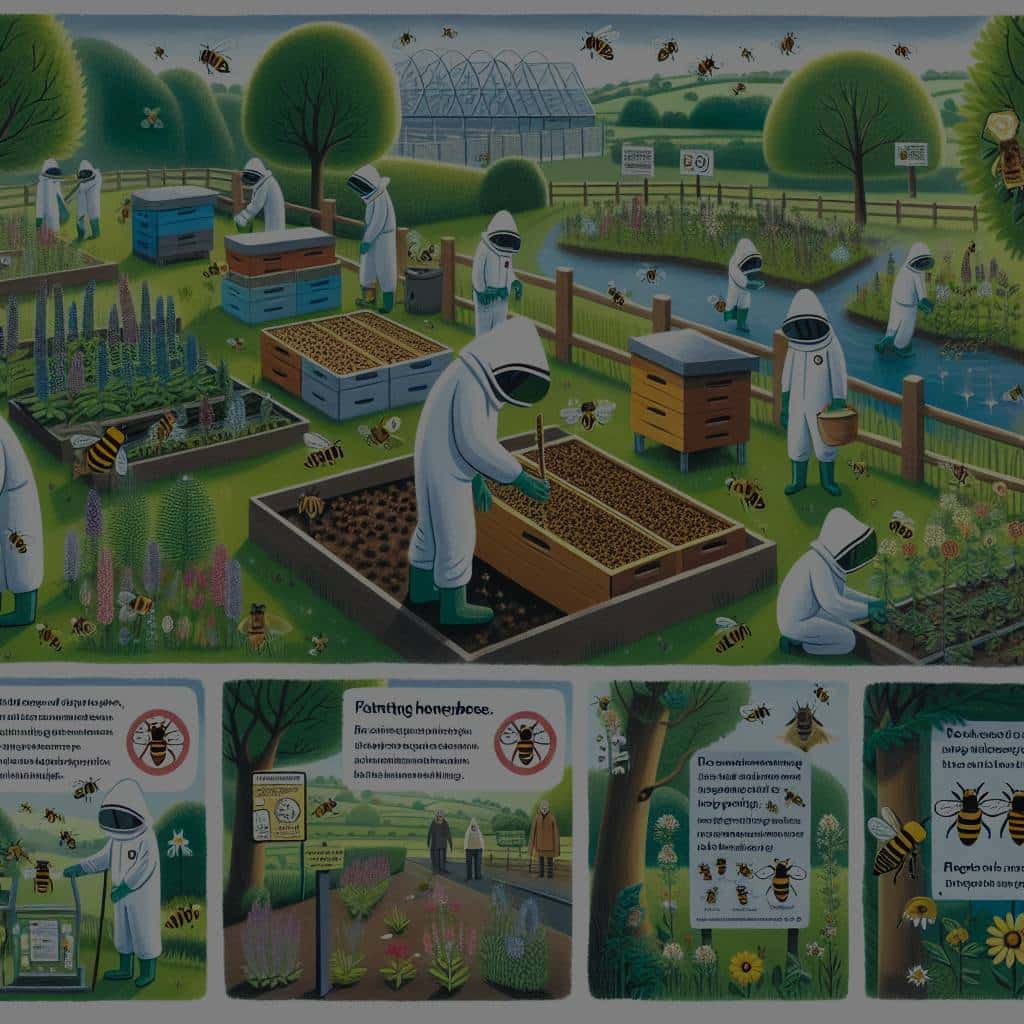What measures are being taken to protect the UK’s honeybee populations from decline?

The plight of the honeybee is a grave concern for all of us. As key pollinators, bees play a crucial role in the cycle of life for many plants and species, directly influencing the food we eat and the health of our ecosystems. However, recent studies from Google Scholar and PubMed have revealed a worrying trend: the population of these vital insects is declining at an alarming rate. The reasons behind this are manifold, from the destructive use of pesticides to poor policy decisions. In this article, we will explore the various measures being taken to protect the UK’s honeybee populations from decline.
The Importance of Bees as Pollinators
Bees are much more than just honey producers. These tireless insects are crucial pollinators, transferring pollen from the male stamens of a flower to the female pistil. This process is essential for plant fertilisation, leading to the production of fruits and seeds. According to CrossRef and Google Scholar, bees are responsible for pollinating approximately 70% of the world’s most important food crops.
Also to read : How to effectively manage screen time for children in the UK’s digital age?
In the UK, the honeybee species is an essential pollinator. Their decline would not only affect the variety of food available but also its affordability. A recent study shared by DOI highlighted that many plants are entirely dependent on bees for their propagation, making their decline a serious concern for food security and our health.
Factors contributing to Honeybee Decline
Understanding the various factors contributing to the honeybee decline is essential to devise effective strategies for their protection. According to research available on PubMed and Google Scholar, a combination of pesticides, habitat loss, disease, and climate change is leading to this decline.
Have you seen this : Dive into the excitement of mystery boxes online today
Among these factors, pesticides have drawn significant attention from many researchers and policy-makers. A recent study published in CrossRef revealed that certain pesticides are harmful to bees, affecting their navigation skills, behaviour, and immunity, leading to their death.
Policies to Protect the Honeybee
The UK government has acknowledged the urgent need to protect honeybees and has introduced several policies to tackle their decline. One such policy is the National Pollinator Strategy, which aims to protect pollinators by minimizing the risks from pesticides, improving the management of farmland, and enhancing the quality of their habitats.
This policy also promotes research into the health and status of pollinators, encouraging the use of DOI to track the impact of these measures. The government has also restricted the use of certain pesticides known to harm bees, following research findings from CrossRef and Google Scholar.
Public Engagement in Honeybee Protection
The protection of honeybees is not just a government task; the public also plays a vital role. There are several initiatives across the UK designed to engage people in honeybee conservation, providing them with the knowledge and tools to create habitats for bees.
From planting bee-friendly plants to reducing the use of pesticides, each one of us can make a difference. Many organizations, such as the British Beekeepers Association, also offer courses and resources on beekeeping, encouraging more people to become beekeepers.
Research and Innovation to Safeguard Honeybees
Alongside policy and public engagement, scientific research and innovation play a crucial role in the protection of honeybees. Researchers are using advanced tools, such as Google Scholar and DOI, to study bees and understand the challenges they face.
For instance, some researchers are studying the effects of pesticides on bees and developing safer alternatives. Others are innovating new ways to protect bees from disease and parasites. There are also projects using technology to monitor bee health and behavior, providing valuable data for conservation efforts.
In conclusion, the decline of honeybees is a pressing issue that requires immediate attention. The UK is taking several measures to protect its honeybee populations, from policy changes and public engagement to research and innovation. These efforts are crucial for the survival of these vital pollinators and the health of our ecosystems. However, the success of these measures will require ongoing commitment, collaboration, and action from all of us.
The Impact of Climate Change and Air Pollution on Honeybees
The changing climate and increasing levels of air pollution have potential implications on honeybee health, contributing to the decline of bee populations. Studies found on Google Scholar suggest a correlation between the shifts in weather patterns, exacerbated by climate change, and the decline in honeybee populations.
Climate change affects the flowering times of plants, which directly affect the availability of nectar and pollen for bees. This mismatch in flowering times can lead to a lack of food for bees, impacting their health and reproduction. Moreover, extreme weather events such as heatwaves, floods, and storms can destroy their habitats and food sources.
Air pollution is another environmental factor negatively affecting bees. Research on Apis mellifera, a species of honeybee, suggests that air pollution, particularly from traffic emissions, can interfere with the ability of bees to find flowers by scent. This challenge in foraging can reduce their efficiency as pollinators and ultimately their survival.
The UK’s approach in addressing these environmental impacts embraces the precautionary principle. This principle implies taking preventive action in the face of uncertainty, especially when the stakes are high, and the potential harm to honey bees is irreversible. Accordingly, the UK government is focusing on implementing climate change mitigation strategies and introducing strict regulations to control air pollution.
The Threat of Varroa Destructor and Other Diseases
Another significant threat to honey bees, particularly the Apis mellifera species, is the Varroa destructor mite. This parasitic mite is one of the leading causes of bee decline globally, according to a study published on Google Scholar. Varroa mites not only weaken bees by feeding on their haemolymph (the bee equivalent of blood) but also transmit several viruses, leading to a higher mortality rate in colonies.
To tackle this issue, the public policy in the UK includes regular monitoring of bee colonies for signs of Varroa destructor and other diseases. Beekeepers are educated on the importance of maintaining bee health by implementing effective pest and disease management strategies. This approach ensures the early detection and treatment of mites and diseases, preventing their spread and maintaining a healthy bee population.
In addition to the Varroa destructor, honeybees are also susceptible to other diseases like American foulbrood and European foulbrood. These bacterial diseases can decimate entire colonies if not managed promptly. Public policy requires beekeepers to report any suspected cases of these diseases, ensuring timely intervention and treatment.
Conclusion
The alarming decline in the UK’s honeybee populations compels us to act with a sense of urgency. The strategies employed to protect these crucial pollinators vary from public policies, adaptive measures against climate change and air pollution, the promotion of bee-friendly habits among the public, to the development of innovative solutions in research and technology.
The government’s adoption of the precautionary principle in safeguarding against potential threats to honeybees represents a significant stride forward. The public’s active engagement, from planting RHS approved bee-friendly plants to learning about beekeeping, is also crucial in creating a favourable environment for bees.
In the realm of research and innovation, the efforts range from studying the effects of neonicotinoid pesticides on bees to studying diseases like the Varroa destructor. These include wild bees and solitary bees, not just honey bees. Meanwhile, technological advancements provide valuable tools in monitoring bee health and behaviour, offering essential insights for conservation strategies.
We all share the responsibility of protecting our precious bee populations, including honey bees, wild bees, and solitary bees. These creatures are more than just honey producers; they are key players in our ecosystems, crucial for our survival and the diversity of life on our planet. By protecting bees, we also protect our food security and the health of our ecosystems. Therefore, let’s continue to work together, applying the lessons we’ve learned and the measures we’ve implemented to ensure the survival of these essential pollinators. Remember, every action, no matter how small, makes a difference.
